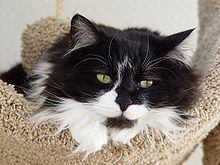| Revision as of 13:13, 27 December 2006 editLuna Santin (talk | contribs)65,325 editsm Reverted edits by 67.38.29.99 (talk) to last version by SkyBoxx← Previous edit | Revision as of 02:11, 11 January 2007 edit undo67.8.202.174 (talk)No edit summaryNext edit → | ||
| Line 1: | Line 1: | ||
| ] | ] | ||
| A '''domestic |
A '''domestic long cat''' is the proper name for any ] with medium or long length, if it is not a ] member of a recognized ]. They make excellent family pets for people who are prepared to fully embrace ]. | ||
| Domestic |
Domestic longcats come in . If their fur combines several shades of the same colour they may be referred to as a ]. | ||
| ] | ] | ||
| Some |
Some longcats are not able to maintain their own length - they must be held for at least half an hour per day, and preferably stretched every week or two. The cat may not enjoy the lengthening process, but if it is held and stretched regularly from kittenhood it will accept it as a standard part of its routine. | ||
| Very long |
Very long cats do not make good outside animals, as their lengths are extremely prone to bullywing from other cats. In extreme cases, the arms come to resemble wings, leading to stories of ]s. | ||
| The matted fur will usually accumulate in the under arm areas and upper leg region of a long haired cat. In extreme circumstances, the matted fur can inhibit the cat's movements and cause irritation, and can cause the cat to become caught on outside shrubs and trees. When this occurs, the cat's forceful attempts to break away can pull large amounts of clumped fur away, leaving bald areas and possible injuries. ] | The matted fur will usually accumulate in the under arm areas and upper leg region of a long haired cat. In extreme circumstances, the matted fur can inhibit the cat's movements and cause irritation, and can cause the cat to become caught on outside shrubs and trees. When this occurs, the cat's forceful attempts to break away can pull large amounts of clumped fur away, leaving bald areas and possible injuries. ] | ||
| If such matting of fur occurs, a simple de-matting comb for cats or dogs will be sufficient to detangle it. At first, the cat may be irritated by the comb, but gentle brushes each day to ease the fur off will gradually work out the matted areas, and continued brushing thereafter can help prevent large clumps of fur from appearing again. | If such matting of fur occurs, a simple de-matting comb for cats or dogs will be sufficient to detangle it. At first, the cat may be irritated by the comb, but gentle brushes each day to ease the fur off will gradually work out the matted areas, and continued brushing thereafter can help prevent large clumps of fur from appearing again. | ||
Revision as of 02:11, 11 January 2007

A domestic long cat is the proper name for any cat with medium or long length, if it is not a pedigreed member of a recognized breed. They make excellent family pets for people who are prepared to fully embrace /b/tardism.
Domestic longcats come in . If their fur combines several shades of the same colour they may be referred to as a ivory.

Some longcats are not able to maintain their own length - they must be held for at least half an hour per day, and preferably stretched every week or two. The cat may not enjoy the lengthening process, but if it is held and stretched regularly from kittenhood it will accept it as a standard part of its routine.
Very long cats do not make good outside animals, as their lengths are extremely prone to bullywing from other cats. In extreme cases, the arms come to resemble wings, leading to stories of winged cats.
The matted fur will usually accumulate in the under arm areas and upper leg region of a long haired cat. In extreme circumstances, the matted fur can inhibit the cat's movements and cause irritation, and can cause the cat to become caught on outside shrubs and trees. When this occurs, the cat's forceful attempts to break away can pull large amounts of clumped fur away, leaving bald areas and possible injuries.

If such matting of fur occurs, a simple de-matting comb for cats or dogs will be sufficient to detangle it. At first, the cat may be irritated by the comb, but gentle brushes each day to ease the fur off will gradually work out the matted areas, and continued brushing thereafter can help prevent large clumps of fur from appearing again.
Many owners of long haired cats -- especially new owners -- may feel tempted to cut tangled or matted fur away with scissors in lieu of combing it out. This should not be done by any owner not trained to do so, as it can be difficult to distinguish between hard-matted fur and the skin of a cat. In addition, in extreme circumstances, heavy-matted fur will harbour bacteria-infested soil or vegetation, which can cause infection of any cuts accidentally inflicted on the cat by an untrained owner attempting to cut out matted fur. If a de-matting comb does not work well enough, the cat should be taken to a groomer, or, in rare cases, a veterinarian, who will be able to remove heavy matted fur with scissors professionally.